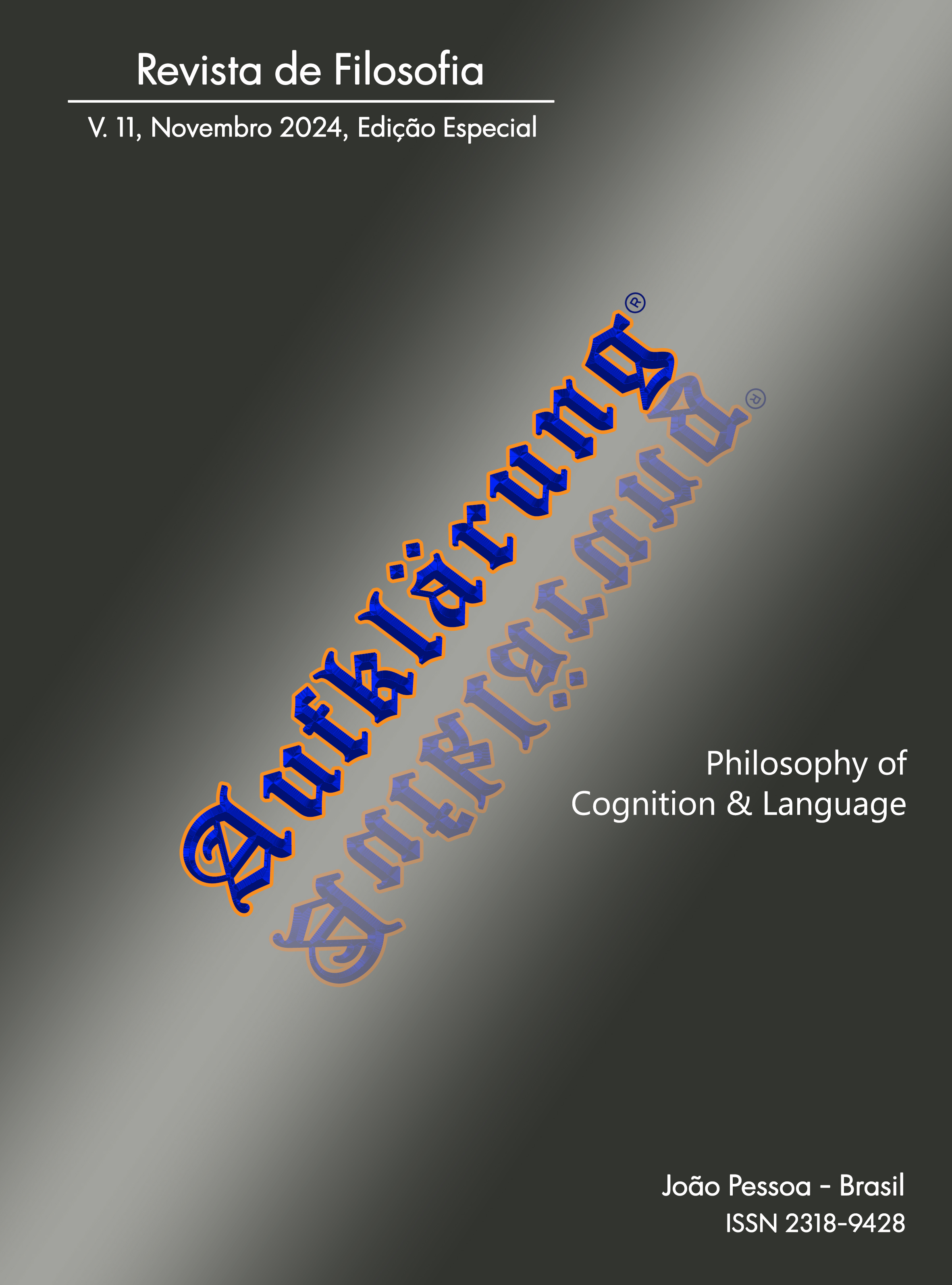Cognición encarnada y placer en la antigua ira cómica
DOI:
https://doi.org/10.18012/arf.v11iEspecial.70047Keywords:
Cognición encarnada, Ciencia de las emociones, Metáforas cognitivas, Emociones antiguas, Comedia griegaAbstract
Este artículo explora la aplicación de un modelo de cognición encarnada como lente para entender la ira en Lisístrata de Aristófanes. Se argumenta que la representación de la ira en esta comedia sigue un patrón encontrado en diferentes géneros de la literatura griega en que la emoción es asociada a un elemento de placer. Este elemento sensorial es encontrado desde una manera más articulada en Aristóteles hasta una variedad de metáforas que conectan la ira y el erotismo en otros autores. La teoría de metáforas conceptuales, cuya principal aserción es que nuestro aparato cognitivo produce su propio mundo de significado que depende del hecho de tener un cuerpo biológico y un contexto psicológico y cultural, provee una herramienta importante para entender las emociones en un texto. La idea de que nuestro lenguaje acarrea información acerca de la forma en que conceptualizamos las cosas arroja luz sobre la relación entre eros e ira en Lysistrata.
Downloads
References
ALLEN, D. The world of Prometheus:the politics of punishing in democratic Athens. New Jersey: Princeton University Press, 2000.
ALLEN, D. Angry bees, wasps, and jurors: the symbolic politics of ὀργή in Athens. In: BRAUND, S. M.; MOST, G. W. (Eds.) Ancient anger perspectives from Homer to Galen. Cambridge: Cambridge University Press, 2003. p. 76-98.
BUDELMANN, F.; EASTERLING, P. Reading minds in Greek tragedy. Greece & Rome,_v. 57, p. 289-303, 2010.
CAIRNS, D. Ethics, ethology, terminology: Iliadic anger and the cross-cultural study of emotion. In: S. M. BRAUND, S. M.; MOST, G. W. (Eds.) Ancient anger perspectives from Homer to Galen. Cambridge: Cambridge University Press, 2003. p. 11-49.
CAIRNS, D. Mind, body, and metaphor in ancient Greek concepts of emotion. L'Atelier du centre de recherche historique, v. 16, p. 2-18, 2016a.
CAIRNS, D. Clothed in shamelessness, shrouded in grief:the role of “Garment” metaphors in ancient Greek concepts of emotion. In: FANFANI, G.; HARLOW, M.; NOSCH, M.-L. (Eds.) Spinning fates and the song of the loom: the use of textiles, clothing and cloth production as metaphor, symbol, and narrative. Oxford: Oxbow Books, 2016b. p. 25-41.
CAMPEGGIANI, P. Aristotle on perceptual interests. Apeiron, v. 53, p. 235-256, 2020.
CLEMENTS, A. “Looking mustard”: Greek popular epistemology and the meaning of δριμύς. In: BUTLER, S.; PURVES, A. (Eds.) Synaesthesia and the Ancient Senses. Durham: Acumen, 2013. p. 71-88.
COLOMBETTI, G. Enaction, sense-making, and emotion. In: STEWART, J. et al. (Eds.) Enaction: toward a new paradigm for cognitive science. Cambridge, MA: The MIT Press, 2014. p. 145-164.
COLOMBETTI, G.; THOMPSON, E. The feeling body: toward an enactive approach to emotion. In: OVERTON, W. et al. (Eds.) Developmental perspectives on embodiment and consciousness. New York: Erlbaum, 2008. p. 45-68.
DE SOUSA, R. The rationality of emotions. Cambridge, MA: The MIT Press, 1987.
DI PAOLO, E. A. Autopoiesis, adaptivity, teleology, agency. Phenomenology and the Cognitive Sciences, v. 4, p. 429-452, 2005.
FORTE, A.S. The cognitive linguistics of Homeric surprise. In: MEINECK, P. et at. (Eds.) The Routledge handbook of classics and cognitive theory. New York: Routledge, 2018. p. 39-58.
FORTENBAUGH, W. W. Aristotle on emotion: a contribution to philosophical psychology, rhetoric, poetics, politics and Ethics. London: Duckworth, 1975.
FORTENBAUGH, W. W. Aristotle’s rhetoric on emotions. In: BARNES, J. et al. (Eds.) Articles on Aristotle, v. 4: psychology and aesthetics. London: Duckworth, 1979. p. 133-153.
GALLAGHER, S. Understanding others: embodied social cognition. In: CALVO, P.; GOMILA, T. (Eds.) Handbook of cognitive science. San Diego: Elsevier Science, 2008. p. 437-452.
GALLESE, V.; LAKOFF, G. The brain’s concepts: the role of the Sensory-motor system in conceptual knowledge. Cognitive Neuropsychology, v. 22, p. 455-479, 2005.
GERRANS, P. The motor of cognition. Consciousness and Cognition, v. 12, p. 510-512, 2003.
GILL, C. Stoicism and epicureanism. In: GOLDIE, P. (Ed.) The Oxford handbook of philosophy of emotion. Oxford: Oxford University Press, 2009. p. 143-166.
GRIFFITHS, P.; SCARANTINO, A. Emotions in the wild: the situated perspective on emotion. In: ROBBINS, P.; AYDEDE, M. (Eds.) The Cambridge handbook of situated cognition. Cambridge: Cambridge University Press, 2008. p. 437-453.
HARRIS, W. V. The rage of women. In: BRAUND, S. M.; MOST, G. W. (Eds.) Ancient anger perspectives from Homer to Galen. Cambridge: Cambridge University Press, 2003. p. 121-143.
HENDERSON, J. The maculate muse: obscene language in Attic comedy. New Haven; London: Yale University Press, 1975.
JOHNSON, M. The body in the mind:the bodily basis of meaning, imagination and reason. Chicago; London: The University of Chicago Press, 1987.
KENNY, A. Action, emotion and will. London; New York: Routledge, [1963] 2003.
KONSTAN, D. The politics of Aristophanes' wasps. Transactions of the American Philological Association, v. 115, p. 27-46, 1985.
KONSTAN, D. Aristotle on anger and the emotions: the strategies of status. In: BRAUND, S. M.; MOST, G. W. (Eds.) Ancient anger perspectives from Homer to Galen. Cambridge: Cambridge University Press, 2003. p. 99-120.
KONSTAN, D. The emotions of the ancient Greeks: studies in Aristotle and classical literature. Toronto: University of Toronto Press, 2006.
LAKOFF, G. Women, fire, and dangerous things: what categories reveal about the mind. Chicago; London: The University of Chicago Press, [1987] 1990.
LAKOFF, G.; JOHNSON, M. Metaphors we live by. Chicago; London: The University of Chicago Press, [1980] 2003.
LAKOFF, G.; JOHNSON, M. Philosophy in the flesh:the embodied mind and its challenge to western thought. New York: Basic Books, 1999.
LAKOFF, G.; JOHNSON, M. Why cognitive linguistics requires embodied realism. Cognitive Linguistics, v. 13, p. 245-263, 2002.
LAKOFF, G.; KÖVECSES, Z. The cognitive model of anger inherent in Americanenglish. In: HOLLAND, D.; QUINN, N. (Eds.) Cultural models in language and thought. New York: Cambridge University Press, 1987. p. 195-221.
LAZARUS, R. Emotion and adaptation. New York: Oxford University Press, 1991.
LEWIS, M. D. Bridging emotion theory and neurobiology through dynamic systems modelling. The Behavioral and Brain Sciences, v. 28, p. 169-194, 2005.
METEYARD, L.; VIGLIOCCO, G. The role of sensory and motor information in semantic representation: areview. In: CALVO, P.; GOMILA, T. (Eds.)_Handbook of cognitive science. San Diego: Elsevier Science, 2008. p. 291-312.
NEU, J. A tear is an intellectual thing. Representations, v. 19, p. 35-61, 1987.
NOVACO, R. W. Anger dysregulation: driver of violent offending. The Journal of Forensic Psychiatry & Psychology, v. 22, p. 650–668, 2011.
NUSSBAUM, M. Upheavals of thought: the intelligence of emotions. New York: Cambridge University Press, 2001.
NUSSBAUM, M. The therapy of desire: theory and practice in hellenistic ethics. New Jersey: Princeton University Press, 2013.
PADEL, R. In and out of the mind: Greek images of the tragic self. New Jersey: Princeton University Press, 1992.
PRICE, A. W. Emotions in Plato and Aristotle. In: GOLDIE, P. (Ed.) The Oxford handbook of philosophy of emotion. Oxford: Oxford University Press, 2009. p. 121-142.
ROSCH, E. Reclaiming concepts. Journal of Consciousness Studies, v. 6, p. 61-77, 1999.
ROSCH, E. “If you depict a bird, give it space to fly": eastern psychologies, the arts, and self-knowledge. SubStance, v. 30, p. 236-253, 2001.
SCHACHTER, S.; SINGER, J. Cognitive, social, and physiological determinants of emotional state. Psychological review, v. 69,p. 379-399, 1962.
SEARLE, J. R. Expression and meaning: studies in the theory of speech acts. Cambridge: Cambridge University Press, 1979.
SOLOMON, R. C. Emotions and choice. The Review of Metaphysics, v. 27, p. 20-41, 1973.
SOLOMON, R. C. The logic of emotion. Noûs, v. 11, p. 41-49, 1977.
SOLOMON, R. C. Emotions, cognition, affect: on Jerry Neu’s a tear is an intellectual thing. Philosophical studies, v. 108, p. 133-142, 2002.
STOCKER, M. Intellectual desire, emotion, and action. In: RORTY, A. O. (Ed.) Explaining emotions. Berkeley: University of California Press, 1980. p. 323-338.
THUMIGER, C. Mad erôs and eroticized madness in tragedy. In: SANDERS, E. et al. (Eds.) Erôs in Ancient Greece. Oxford: Oxford University Press, 2013. p. 27-40.
VARELA, F. J.; THOMPSON, E.; ROSH, E.The embodied mind: cognitive science and human experience. Cambridge, MA: The MIT Press, 1991.
WEBER, A.; VARELA, F. J. Life after Kant: natural purposes and the autopoietic foundations of biological individuality. Phenomenology and the Cognitive Sciences, v. 1, p. 97-125, 2002.
WORMAN, N. Abusive mouths in classical Athens. Cambridge: Cambridge University Press, 2008.
ZEITLIN, F. Travesties of gender and genre in Aristophanes' “Thesmophoriazousae”. Critical Inquiry, v. 8, p. 301-327, 1981.
Additional Files
Published
How to Cite
Issue
Section
License

This work is licensed under a Creative Commons Attribution 4.0 International License.
Journal general policy
1.This journal works under a Creative Commons License aplied to online journals. That icence can be read in the following link: Creative Commons Attribution 4.0 International (CC BY 4.0).
2.Accordingly to this License, a)the journal declares that authors hold the copyright of their articles without restrictions, and they can archieve them as post-print elsewhere. b)the journal allow the author(s) to retain publishing rights without restrictions.
Metadata Policy for information describing items in the repository
1. Anyone may access the metadata free of charge at anytime.
2.The metadata may be re-used in any medium without prior permission, even commercial purposes provided the OAI Identifier or a link to the original metadata record are given, under the terms of a CC BY license refered for the Journal.







































